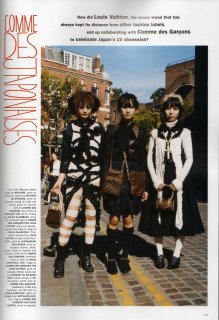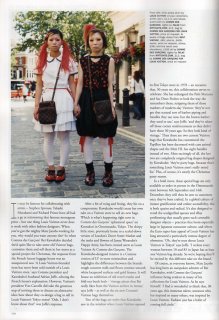Comme des Garcons partners with Louis Vuitton
By Suzy Menkes
Friday, June 27, 2008
PARIS: In an extraordinary collaboration, Louis Vuitton, the ultimate French luxury brand, and Rei Kawakubo of Comme des Garcons, the ultimate fashion rebel, will open a joint Tokyo store in September – an ephemeral three-month space where six one-off bags, designed by Kawakubo in the LV monogram pattern, can be ordered by shoppers. Yves Carcelle, chairman and chief executive of Louis Vuitton, sitting front row at Kawakubo's show on Friday, said that he was approached by Comme and considers the project a fine way to celebrate 30 years since Vuitton first opened in Tokyo. Backstage, Kawakubo said that memory of her excitement at the arrival of Parisian luxury in Japan in 1978, resulted in this unlikely idea of the new design duo creating the store within the Comme des Garcons shop off Omotosando. For Comme acolytes, this move will be considered either as sleeping with the enemy – or a brilliant and imaginative partnership. Kawakubo has re-designed the entire Comme des Garcons store on Kottodori, Omotesando for the Vuitton project. Carcelle says that LV is investing in the store, and that any financial profits will be divided. Although there have been many recent collaborations between "high" and "low" fashion, starting with Karl Lagerfeld's mini collection for the fast-fashion chain H&M, this meld is different because it involves a beacon of individuality with a company at the heart of corporate luxury management, as part of the LVMH (Moet Hennessy Louis Vuitton) group. Carcelle said that Marc Jacobs, artistic director of Louis Vuitton, admired Comme des Garcons and was an enthusiastic supporter of the idea of a joint venture. "It is impossible to overstate Rei Kawakubo's influence on modern fashion," Jacobs said in a prepared statement. "I find it wonderful to think that 30 years ago, this immense talent, someone who has inspired so many others, was inspired by Louis Vuitton." Kawakubo described her designs as "party" bags, promising multi-handles or two handles morphing into one. All will use the monogram toile, with the LV initials, and the offerings will hark back to the styles of 30 years when Vuitton made only bags and leather goods.
For Comme acolytes, the move will be considered either as sleeping with the enemy or as a brilliant and imaginative partnership. It could also be a riposte to Yohji Yamamoto's bag collaboration with Hermès last season. There was a touch of the spirit of that other Japanese fashion hero in Comme's men-in-skirts - crisp white cotton worn over narrow pants and under tailored jackets or shorter tunic dresses.
The show, with its slightly ethnic layering, was almost entirely in black and white, with its graphic quality enhanced by polka dots on inside-out jacket linings or on "petticoats" under full skirts. Flaming red hair or rakish hats finished off the look. But there were none of the customized LV bags with "kawaii," or cutesy, charms, to be seen.
The show was graceful and poetic, rather than one of Kawakubo's mold-breaking collections. But then she had already dropped her fashion collaboration bombshell, whose reverberations will be felt throughout the long weekend of Paris men's fashion.
Louis Vuitton's own show seemed to be on a fashion road to nowhere, although the designer Paul Helbers made all the right moves. He removed intrusive logos; gave an airy freedom to sportswear; and worked with a color palette that started bright, white and light, was then tinged with pastel - and finally broke into sunset orange before a nightfall of black.
What was the problem? The collection did not seem to grow from the DNA of Vuitton, a brand deeply associated with travel. After seeing in Milan's fashion week so much focus on modern materials and sartorial travel aids, Vuitton seemed to be focused on traditional luxury, with fabrics like cotton and silk for a trench coat, linen canvas for a vest and a champagne-colored suede top. The bags were luxurious and stylish and, as a replacement for the logo, shoes had a cradle of straps at the toes like a fancy spat - a subversive trend in footwear.
(......)
 Hopefully someone else has seen this Mr Bean episode ...
Hopefully someone else has seen this Mr Bean episode ... Hopefully someone else has seen this Mr Bean episode ...
Hopefully someone else has seen this Mr Bean episode ...



